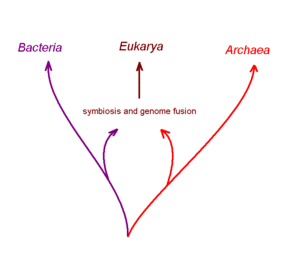Evolution of cells
- See also: Eukaryotes, Archaea, Bacteria
"The evolution of modern cells is arguably the most challenging and important problem the field of Biology has ever faced. In Darwin's day the problem could hardly be imagined. For much of the 20th century it was intractable. In any case, the problem lay buried in the catch-all rubric "origin of life"---where, because it is a biological not a (bio)chemical problem, it was effectively ignored. Scientific interest in cellular evolution started to pick up once the universal phylogenetic tree, the framework within which the problem had to be addressed, was determined (refs. 3 and 4; Fig. 1). But it was not until microbial genomics arrived on the scene that biologists could actually do much about the problem of cellular evolution." (Carl Woese, 2002) [1]
The common ancestor of eukaryotes, bacteria, and archaea may well have been a community of organisms that readily exchanged components and genes. It would have contained:
- Autotrophs that produced organic compounds from CO2 either photosynthetically or by inorganic chemical reactions;
- Heterotrophs that obtained organics by leakage from other organisms;
- Saprotrophs that absorbed nutrients from decaying organisms; and phagotrophs that were sufficiently complex to envelop and digest prey.
How the current lineages of microbes evolved from this postulated community is currently unsolved but subject to intense research by biologists, stimulated by the great flow of new discoveries emerging from genome science.[2]

Instead of relying a single gene such as the SSU rRNA gene to reconstruct early evolution, or a few genes, scientific effort has shifted to exploiting the comprehensive information from the many complete genome sequences of organisms that are now available.[3]
It is now clear that trees based only on SSU rRNA alone do not capture the events of early eukaryote evolution accurately, and the origins of the first nucleated cells are still uncertain. For instance, careful analysis of the complete genome of the eukaryote yeast shows that many of its genes are more closely related to bacterial genes than they are to archaea, and it is now clear that archaea were not the simple progenitors of the eukaryotes, in stark contradiction to the findings based on SSU rRNA and limited samples of other genes.[4]
One imaginative but disputed hypothesis getting some support from recent computer-assisted studies of complete genome DNA sequences is that the first nucleated cell arose from two distinctly different ancient prokaryotic (non-nucleated) species that had formed a symbiotic relationship with one-another to carry out different aspects of metablism. One partner of this postulated symbiosis is proposed to be a true bacterial cell, and the other an archaean cell. It is postulated that this symbiotic partnership progressed via the cellular fusion of the partners to generate a chimeric or hybrid cell with a membrane bound internal structure that was the forerunner of the nucleus. The next stage in this scheme was transfer of both partner genomes into the nucleus and their fusion with one-another. Several variations of this hypothesis for the origin of nucleated cells have been suggested[5],
But some biologists dispute this conception[6] and argue for the need for a shift in conceptual framework if this problem is to be solved - and point out that early living communities would compise many different entities to extant cells, and would have shore their genetic material more extensively than current microbes.[7]
References
Citations
- ↑ Woese C (2002) On the evolution of cells. Proc Natl Acad Sci USA 99:8742-7 PMID 12077305 This article shifts the emphasis in early phylogenic adaptation from vertical to horizontal gene transfer. (Open access.)
- ↑ Kurland CG et al. (2006) Genomics and the irreducible nature of eukaryote cells. Science 312(5776):1011-4 PMID 16709776
- ↑ Daubin V et al. (2003) Phylogenetics and the cohesion of bacterial genomes. Science 301:829-32 PMID 12907801
- Eisen JA, Fraser CM (2003) Viewpoint phylogenomics: intersection of evolution and genomics. Science 300:1706-7 PMID 12805538
- Henz SR et al. (2005) Whole-genome prokaryotic phylogeny. Bioinformatics 21:2329-35 PMID 15166018
- ↑ Esser C et al. (2004) A genome phylogeny for mitochondria among alpha-proteobacteria and a predominantly eubacterial ancestry of yeast nuclear genes. Mol Biol Evol 21:1643-50 PMID 15155797
- Rivera MC, Lake JA (2004) The ring of life provides evidence for a genome fusion origin of eukaryotes. Nature 431:152-5 PMID 15356622
- Simonson AB et al. (2005) Decoding the genomic tree of life. Proc Natl Acad Sci USA 102 Suppl 1:6608-13 PMID 15851667
- ↑ Esser C et al. (2004) A genome phylogeny for mitochondria among alpha-proteobacteria and a preedominantly eubacterial ancestry of yeast nuclear genes. Mol Biol Evol 21:1643-50 PMID 15155797
- ↑ Kurland CG et al. (2006) Genomics and the irreducible nature of eukaryote cells. Science 312(5776):1011-4 PMID 16709776
- ↑ Woese C (2002) On the evolution of cells. Proc Natl Acad Sci USA 99:8742-7 PMID 12077305
Further reading
- Daubin V et al. (2003) Phylogenetics and the cohesion of bacterial genomes. Science 301:829-32 PMID 12907801
- Eisen JA, Fraser CM (2003) Viewpoint phylogenomics: intersection of evolution and genomics. Science 300:1706-7 PMID 12805538
- Fitzpatrick DA et al. (2006) A fungal phylogeny based on 42 complete genomes derived from supertree and combined gene analysis. BMC Evol Biol 6:99 PMID 17121679
- Ge F et al. (2005) The Cobweb of Life revealed by genome-scale estimates of horizontal gene transfer. PLoS Biology 3:e316 PMID 16122348
- Henz SR et al. (2005) Whole-genome prokaryotic phylogeny. Bioinformatics 21:2329-35 PMID 15166018
- Lerat E et al. (2005) Evolutionary origins of genomic repertoires in bacteria. PLoS Biology 3:e130 PMID 15799709
- Steenkamp ET et al. (2006) The protistan origins of animals and fungi. Mol Biol Evol 23:93-106 PMID 16151185]
- Urwin R, Maiden MC (2003) Multi-locus sequence typing: a tool for global epidemiology. Trends Microbiol 11:479-87 PMID 14557031